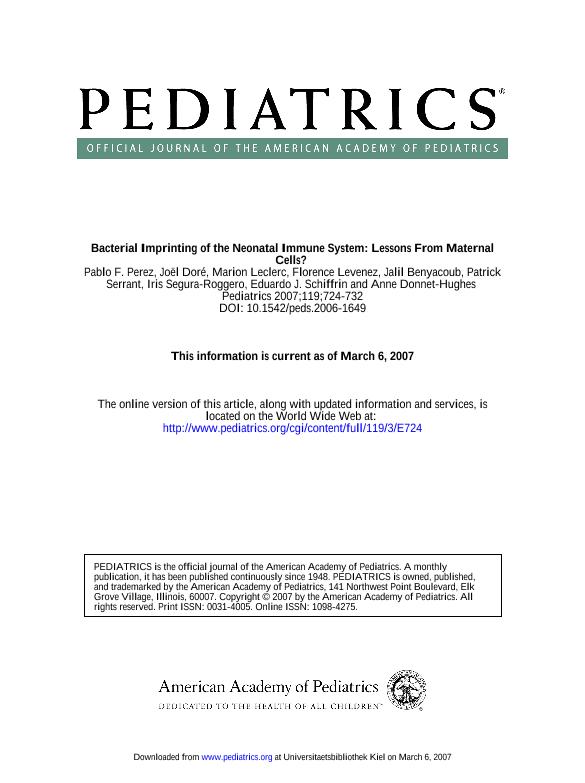Mostrar el registro sencillo del ítem
dc.contributor.author
Perez, Pablo Fernando

dc.contributor.author
Doré, Joel
dc.contributor.author
Leclerc, Marion
dc.contributor.author
Levenez, Florence
dc.contributor.author
Benyacoub, Jalil
dc.contributor.author
Serrant, Patrick
dc.contributor.author
Segura Roggero, Iris
dc.contributor.author
Schiffrin, Eduardo J.
dc.contributor.author
Donnet Hughes, Anne
dc.date.available
2020-07-28T16:34:33Z
dc.date.issued
2007-06
dc.identifier.citation
Perez, Pablo Fernando; Doré, Joel; Leclerc, Marion; Levenez, Florence; Benyacoub, Jalil; et al.; Bacterial Imprinting of the Neonatal Immune System: Lessons From Maternal Cells?; American Academy of Pediatrics; Pediatrics; 119; 3; 6-2007; e724-e732
dc.identifier.issn
0031-4005
dc.identifier.uri
http://hdl.handle.net/11336/110456
dc.description.abstract
OBJECTIVE. We examined the presence of a natural bacterial inoculum in breast milk and its intracellular transport from the maternal intestine to the breast through the circulation. METHODS. Breast milk and peripheral blood were collected aseptically from healthy donors at various times after delivery, and the presence of viable bacteria was determined through plating. Temporal temperature gradient gel electrophoresis was used to examine the bacterial ribosomal DNA content in milk cells, maternal peripheral blood mononuclear cells, and feces and in corresponding infant feces. Blood from nongravid nonlactating women served as control samples. Bacterial translocation to extraintestinal tissues was also evaluated in virgin, pregnant, and lactating mice. RESULTS. Breast milk contained a low total concentration of microbes of <103 colony-forming units per mL. Temporal temperature gradient gel electrophoresis revealed that maternal blood and milk cells contained the genetic material of a greater biodiversity of enteric bacteria. Some bacterial signatures were common to infant feces and to samples of maternal origin. Bacterial translocation from the gut to mesenteric lymph nodes and mammary gland occurred during late pregnancy and lactation in mice. CONCLUSIONS. Bacterial translocation is a unique physiologic event, which is increased during pregnancy and lactation in rodents. Human breast milk cells contain a limited number of viable bacteria but a range of bacterial DNA signatures, as also found in maternal peripheral blood mononuclear cells. Those peripheral blood mononuclear cells showed greater biodiversity than did peripheral blood mononuclear cells from control women. Taken together, our results suggest that intestinally derived bacterial components are transported to the lactating breast within mononuclear cells. We speculate that this programs the neonatal immune system to recognize specific bacterial molecular patterns and to respond appropriately to pathogens and commensal organisms.
dc.format
application/pdf
dc.language.iso
eng
dc.publisher
American Academy of Pediatrics

dc.rights
info:eu-repo/semantics/openAccess
dc.rights.uri
https://creativecommons.org/licenses/by-nc-sa/2.5/ar/
dc.subject
Bacterial translocation
dc.subject
Breast milk
dc.subject
Immunity
dc.subject
Maternal and child health
dc.subject
Lactation
dc.subject.classification
Alimentos y Bebidas

dc.subject.classification
Otras Ingenierías y Tecnologías

dc.subject.classification
INGENIERÍAS Y TECNOLOGÍAS

dc.title
Bacterial Imprinting of the Neonatal Immune System: Lessons From Maternal Cells?
dc.type
info:eu-repo/semantics/article
dc.type
info:ar-repo/semantics/artículo
dc.type
info:eu-repo/semantics/publishedVersion
dc.date.updated
2020-07-20T20:21:14Z
dc.identifier.eissn
1098-4275
dc.journal.volume
119
dc.journal.number
3
dc.journal.pagination
e724-e732
dc.journal.pais
Estados Unidos

dc.journal.ciudad
Elk Grove Village
dc.description.fil
Fil: Perez, Pablo Fernando. Provincia de Buenos Aires. Gobernación. Comisión de Investigaciones Científicas. Centro de Investigación y Desarrollo en Criotecnología de Alimentos. Consejo Nacional de Investigaciones Científicas y Técnicas. Centro Científico Tecnológico Conicet - La Plata. Centro de Investigación y Desarrollo en Criotecnología de Alimentos. Universidad Nacional de La Plata. Facultad de Ciencias Exactas. Centro de Investigación y Desarrollo en Criotecnología de Alimentos; Argentina
dc.description.fil
Fil: Doré, Joel. Nestlé Research Centre. Nestec; Francia
dc.description.fil
Fil: Leclerc, Marion. National Institute for Agronomic Research. Unit for Ecology and Physiology of the Digestive Tract; Francia
dc.description.fil
Fil: Levenez, Florence. National Institute for Agronomic Research. Unit for Ecology and Physiology of the Digestive Tract; Francia
dc.description.fil
Fil: Benyacoub, Jalil. Nestlé Research Centre. Nestec; Francia
dc.description.fil
Fil: Serrant, Patrick. Nestlé Research Centre. Nestec; Francia
dc.description.fil
Fil: Segura Roggero, Iris. Nestlé Research Centre. Nestec; Francia
dc.description.fil
Fil: Schiffrin, Eduardo J.. Nestlé Research Centre. Nestec; Francia
dc.description.fil
Fil: Donnet Hughes, Anne. Nestlé Research Centre. Nestec; Francia
dc.journal.title
Pediatrics
dc.relation.alternativeid
info:eu-repo/semantics/altIdentifier/url/https://pediatrics.aappublications.org/content/119/3/e724
dc.relation.alternativeid
info:eu-repo/semantics/altIdentifier/doi/https://doi.org/10.1542/peds.2006-1649
Archivos asociados
